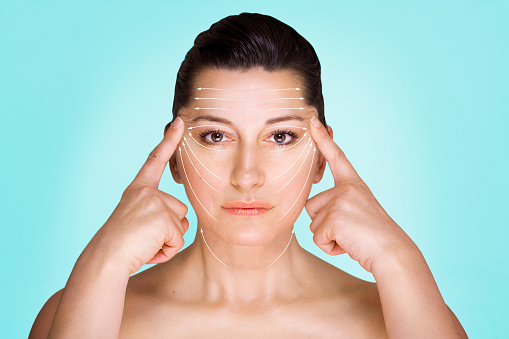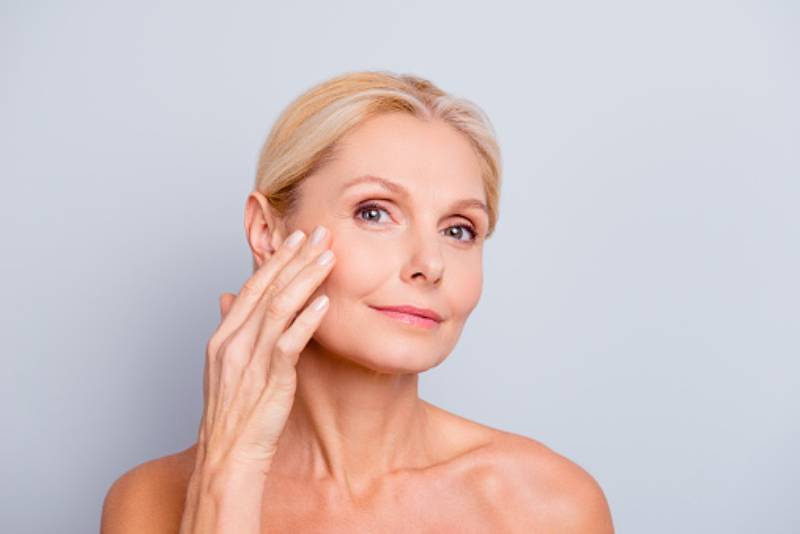There are several procedures available for skin tightening, and the best procedure for you will depend on your specific needs and goals. Here are some of the most commonly used procedures:
- Radiofrequency (RF) skin tightening: This non-invasive treatment uses radiofrequency energy to heat the skin, which stimulates collagen production and tightens loose skin. It is a painless procedure with no downtime.
- Ultrasound skin tightening: This treatment uses ultrasound waves to penetrate the skin and stimulate collagen production, resulting in tighter skin. It is also non-invasive and painless.
- Laser skin tightening: This procedure uses laser energy to heat the skin and stimulate collagen production. It is a non-invasive treatment that requires no downtime.
- Chemical peels: These use a chemical solution to remove the outer layer of skin, which promotes new skin growth and can tighten loose skin.
- Surgical procedures: These include facelifts, neck lifts, and brow lifts, which involve removing excess skin and tightening the underlying tissue. These procedures are more invasive and require a longer recovery time.
It is important to consult with a board-certified dermatologist or plastic surgeon to determine which procedure is best for you based on your specific skin concerns and desired outcome.

How can I tighten face skin?
Tightening facial skin can be achieved through a combination of non-invasive treatments, topical care, and lifestyle changes. Here are the most effective methods:
1. Non-Invasive Treatments
- Microneedling: Small needles create tiny punctures in the skin, stimulating collagen and elastin production. This improves skin texture, tightens the skin, and reduces fine lines and sagging.
- Radiofrequency (RF) Treatments: RF energy heats the deep layers of the skin, which encourages collagen production and tightens the skin. Popular treatments include Thermage and Exilis.
- Ultherapy: This treatment uses ultrasound energy to lift and tighten the skin by stimulating collagen production at deeper layers.
- Laser Treatments: Fractional lasers (like CO2 or erbium lasers) help promote skin regeneration and collagen production, leading to tighter skin over time. Non-ablative lasers also stimulate collagen without damaging the surface.
- Thread Lifts: A minimally invasive procedure where threads are inserted under the skin to lift sagging areas. Over time, the threads stimulate collagen production, providing a tighter and more youthful appearance.
- Cryolipolysis (CoolSculpting): While typically used for fat reduction, it can also help tighten skin in areas like the jawline after fat cells are frozen and removed.
2. Topical Treatments
- Retinoids (Vitamin A): Retinol and other retinoids increase cell turnover and stimulate collagen production. This helps improve skin texture, elasticity, and firmness over time.
- Vitamin C: Known for its collagen-boosting properties, Vitamin C helps stimulate collagen production and brightens the skin. It’s often found in serums and creams.
- Peptides: These amino acids can help stimulate collagen and elastin production, improving skin texture and tightening.
- Hyaluronic Acid: While primarily hydrating, hyaluronic acid also helps plump and firm the skin by attracting moisture and supporting skin structure.
- Growth Factors: Topical products containing growth factors (proteins that help repair skin cells) can encourage collagen regeneration and improve skin elasticity.
3. Lifestyle Changes
- Hydration: Drinking plenty of water helps keep the skin plump and hydrated, which can reduce the appearance of sagging and fine lines.
- Sun Protection: Protecting your skin from UV rays is crucial for maintaining collagen levels. Use sunscreen daily to prevent collagen breakdown caused by sun exposure.
- Healthy Diet: A diet rich in antioxidants (like vitamins C and E) and foods that support collagen production (such as bone broth, fish, nuts, and leafy greens) can improve skin elasticity.
- Avoid Smoking and Excessive Alcohol: Both smoking and heavy drinking accelerate collagen breakdown, so limiting these habits can help preserve skin health.
- Facial Exercises: While evidence on their effectiveness is limited, facial exercises can help tone and firm the muscles beneath the skin, which may give the appearance of tighter skin.
- Adequate Sleep: Sleep is when your body repairs itself, and getting enough rest helps your skin regenerate and produce collagen.
4. Surgical Options (for Significant Laxity)
- Facelift Surgery: If non-invasive methods aren’t enough, a surgical facelift can provide more dramatic and long-lasting results by tightening and lifting the skin.
- Blepharoplasty (Eyelid Surgery): If the skin around your eyes has sagged significantly, eyelid surgery can tighten the skin for a more youthful look.
Each method has its benefits and is suited to different levels of skin sagging or aging. For optimal results, combining multiple approaches, like topical treatments alongside professional procedures, often works best. It’s a good idea to consult with a dermatologist or cosmetic professional to determine the best plan based on your individual needs and skin type
Is skin tightening good for you?
Skin tightening procedures can be beneficial for individuals who are looking to improve the appearance of loose or sagging skin. These procedures can help restore a more youthful, lifted appearance to the skin, which can boost confidence and improve self-esteem.
Additionally, many skin tightening treatments stimulate collagen production, which is essential for maintaining healthy, youthful-looking skin. Collagen is a protein that helps provide structure and elasticity to the skin, and as we age, our bodies produce less collagen, leading to the formation of wrinkles and sagging skin.
However, it is important to note that not all skin tightening procedures are suitable for everyone, and there are potential risks and side effects associated with each treatment. It’s important to consult with a board-certified dermatologist or plastic surgeon to determine which procedure is right for you and to discuss the potential risks and benefits.
Overall, skin tightening procedures can be a safe and effective way to improve the appearance of loose or sagging skin, but it’s important to approach them with caution and to consult with a qualified professional before undergoing any treatment.
How can I restore collagen in my face?
Collagen is a protein that is essential for maintaining healthy, youthful-looking skin. As we age, our bodies produce less collagen, which can lead to the formation of wrinkles, fine lines, and sagging skin. However, there are several ways to help restore collagen in your face, including:
- Use skin care products containing retinoids: Retinoids, such as retinol, are derivatives of vitamin A that can help boost collagen production in the skin. Look for skincare products that contain retinoids, but be sure to start with a low concentration and gradually increase over time to avoid irritation.
- Add vitamin C to your skincare routine: Vitamin C is an antioxidant that can help protect the skin from damage and boost collagen production. Look for serums or moisturizers containing vitamin C to add to your skincare routine.
- Consider collagen supplements: Collagen supplements can help replenish the collagen in your skin from the inside out. Look for supplements containing hydrolyzed collagen, which is broken down into smaller molecules for easier absorption.
- Get enough sleep: Sleep is essential for cell regeneration and collagen production. Aim for 7-8 hours of sleep each night to help your body produce collagen.
- Protect your skin from the sun: Sun damage can lead to a decrease in collagen production. Make sure to wear sunscreen and protective clothing when spending time outdoors.
- Try skin treatments that stimulate collagen production: Some non-invasive skin treatments, such as microneedling and laser therapy, can help stimulate collagen production in the skin.
Keep in mind that while these methods may help stimulate collagen production, they may not be effective for everyone. It’s important to consult with a dermatologist or skincare professional to determine the best approach for your specific skin concerns.
